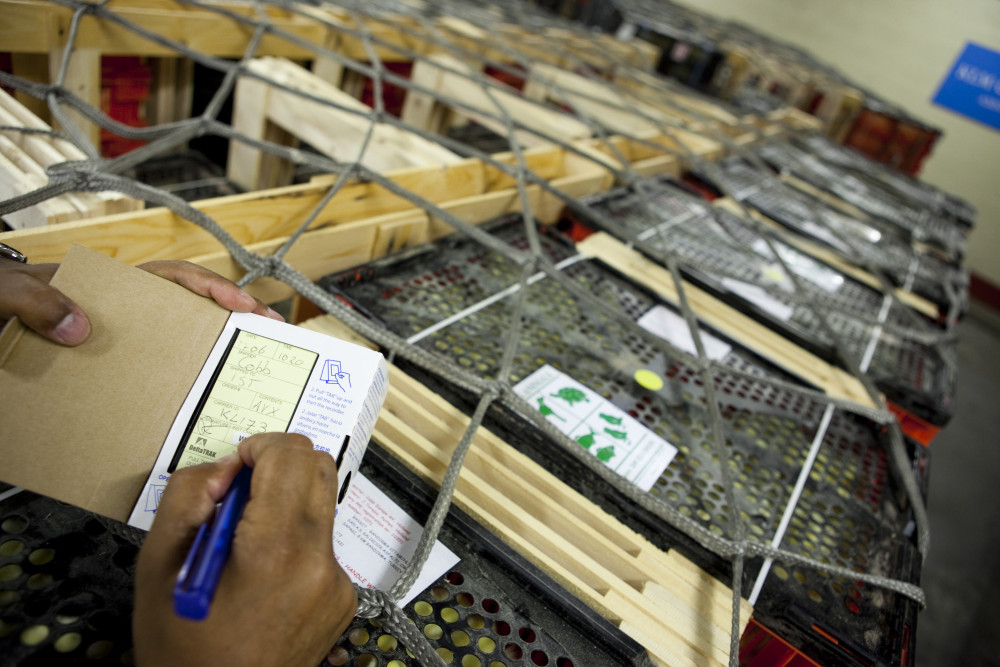The effects of highly pathogenic avian influenza (HPAI) on the international trade of live poultry (i.e. hatching eggs and day-old hatchlings) carry economic, food production, and public health implications. These impacts include disruptions and restrictions primarily driven by the policies adopted by importing countries upon announcement of disease presence in exporting ones.
Trade Policies
Trade restrictions vary from extreme (i.e. country-level) to moderate. The moderate level is regionalized and applies to state, county (or other municipality as a political division within a country), or a more defined area such as that proposed by the World Organization for Animal Health (WOAH, previously known as OIE) of 10 km radius around an index case whereby any poultry within that 10-km circle becomes ineligible for trade whereas poultry populations outside of that area are eligible for trade.
Depending on the level of trust and cooperation between countries, trade policies may be immediately enforced upon disease presence. After which may lag on for days or even weeks. For the best and most effective implementation of trade policies, importing countries must work with the veterinary authorities of the exporting country and rely on them to impose limitations on trade according to a pre-set protocol. Otherwise, negotiations that take place when an outbreak is already ongoing will take time with economic and production losses along the way.
Boundaries and Zones
The regional approach is known as regionalization, also referred to as zoning, and is based on a defined geographical area that is subject to trade restrictions. The boundaries can be natural (e.g. rivers, mountains, canyons, forests), political divisions (e.g. country, state, county) or something more specifically applied to the index case location. The latter approach places the index case as the center of a defined zone from which sets distances for specific actions and restrictions to animal movement. The usual distance for zoning against HPAI outbreaks is a circle defined by a 10 km radius around the index premises. Currently, per WOAH’s guidelines, the period of restrictions is 28 days once practices of virus elimination (i.e. cleaning and disinfection) have been completed. In the event additional cases are confirmed within a region under restrictions, the subsequent events inevitably prolong the duration of time for that region to be considered free of HPAI.
The duration of restrictions is not always in adherence to WOAH’s guidelines, as some countries may have different policies that can go as long as 12 months, and a few even reserve the right to maintain restrictions for an undetermined period that can last for years. This is not concordant to fair trade policies.
The disruption of trade can cause tremendous financial losses for poultry producers and exporters. As usual, when the level of disruption is large enough to significantly impact the food production and distribution chains, the consumer eventually ends up paying the highest price (e.g. supply shortages and high prices).
Compartmentalization
As noted, the regionalization approach is based on geographic areas of land to define what animal subpopulations may be eligible for animal movement (i.e. trade) and does not discriminate between the actual health status of subpopulations within areas under movement restrictions, in a way, punishing those subpopulations that remain disease-free but which fall within the boundaries of the region under restriction imposed upon the presence of disease. An alternative approach to regionalization that would allow animal subpopulations to be traded if they can demonstrate they are disease-free would not need to be based on geographic separation. This alternative is known as compartmentalization and is based on a management plan of individual subpopulations of birds that demonstrates freedom from infection. Thus, for recognized compartments, the product would be eligible for trade even in the presence of disease in the region where the compartment is located. This plan is founded on principles of biosecurity carefully tailored to address epidemiological risks identified as potential threats to that animal subpopulation, after a careful study of the physical characteristics of the premises, their management, and biosecurity procedures.
Compartmentalization’s result is the supply of product free from infection as demonstrated by the frequency of testing contemplated within the plan. The concept of compartmentalization was proposed by WOAH in the early 2000s although it has been until very recent times that it has gained some traction, perhaps due to the nearly global spread of HPAI since 2020. After several years of frequent and recurring outbreaks in multiple regions of the world, countries are searching for alternatives to continue international trade under conditions that pose lower risks of further disease spread. Zoning and compartmentalization offer the most practical alternatives.
Vaccination and trade
Mitigation strategies for HPAI must include robust biosecurity plans for the operation to succeed at maintaining animal subpopulations disease-free. Vaccination has been proclaimed as the alternative that could bring successful disease-free status for HPAI; however, while vaccination might reduce or even prevent clinical signs and mortality, it does preclude the possibility of infection.
Currently, many countries have policies that restrict international trade when vaccination against HPAI is implemented. In some instances, such policies may apply to flock level; however, importing countries want to have assurances of getting products free of infection. This means that testing protocols have to offer the ability to distinguish animals that have been vaccinated from those vaccinated that may have been infected by the field virus.
According to the guidelines for trade by WOAH, countries that practice vaccination against AI should not be subjected to trade restrictions if they can demonstrate freedom from infection, but therein lays a hurdle because testing is not always able to differentiate vaccinated from infected flocks. Furthermore, the frequency of surveillance testing within regions where vaccination occurs has to be conducted at a frequency to demonstrate the absence of viral circulation and cycling within and between flocks within a region. Thus, in countries with a substantial proportion of their domestic production being traded internationally, such as Brazil, the USA, the EU, and Thailand, vaccination against AI is one of the last avenues to consider in their efforts to keep this disease out of their domestic flocks.
Even though general guidelines exist to establish surveillance protocols of flocks vaccinated against AI, the lack of experience in situations where vaccination and effective surveillance to demonstrate freedom from infection leave countries with a sense of insecurity about the safety of trade. Many other factors also play a role in the determination to implement such an approach or not, including indemnification programs, production type, length of productive life of the flocks, vaccine type, and vaccine availability, among others.
Cooperative Efforts
International cooperation, and collaborative efforts between governments, poultry industry stakeholders, and international organizations are essential for effective HPAI control and mitigation of its impact on international trade. This is easier said than done as it requires a lot of cooperation and mutual trust between trading partners. Trust is built upon transparent reporting and open diplomatic relations between countries. By understanding the implications of HPAI on the international trade of hatching eggs and chicks, stakeholders can take appropriate measures to minimize disruptions, protect public health, and ensure the sustainable development of the poultry industry.
It's important to note that the specific impact of HPAI and vaccination against it on international trade can vary depending on the trade policies of individual countries, the effectiveness of implemented mitigation strategies, and the severity of the outbreak. Thus, the decision of a country to vaccinate or not will be specific to the circumstances of that particular country as not all possess the same structure of public and private veterinary services, and funds to support the efforts related to the costs associated with vaccination (vaccine production, distribution, application, measurements of effectiveness), surveillance (passive, active, commercial and non-commercial poultry, wildlife) and the unintended implications on trade.


